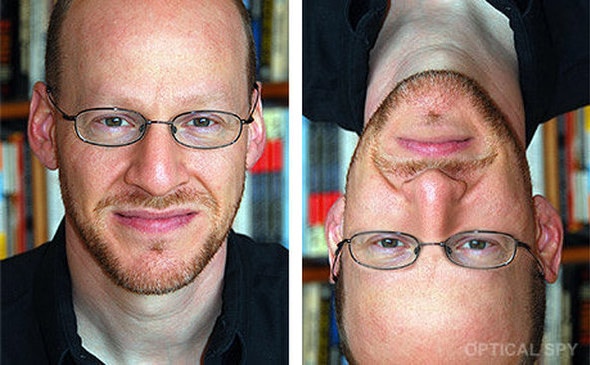Create a free profile to get unlimited access to exclusive videos, sweepstakes, and more!
An Illusion That Makes Me Happy and Sad

I’m normally a pretty cheerful guy, though I do have my moods. I’m not very good at hiding them, either, I’ll admit. So when you look at the photo below, would you say my mood as depicted on the left is the same as on the right, when the picture is inverted?
You might. But if you do, your brain has fooled you: You’ve become a victim of its wonky way of perceiving the world.
Don’t believe me? Take a look at the same two pictures flipped upside for proof:
Distressing, isn’t it? This image comes from Optical Spy, and it’s an example of a well-known but still not completely understood effect called the Margaret Thatcher illusion. Yes, seriously, that’s its name. The illusion was first published using an image of the prime minister, and the name has stuck. Optical Spy has done this trick with quite a few skeptics and other well-known illusion-lovers; I was surprised and pleased to find my own goofy mug there.
As you can see, the first images are the same, except in the one on the right my eyes and mouth have been individually inverted (this process is called—yes, really—thatcherization). When the whole picture is then flipped, our brains have a hard time seeing it. Yet it becomes glaringly obvious when that image is flipped back. Whoever did the image of my face did a good job blending the edges of the edited regions; usually the pictures are just cut-and-paste, making it even weirder looking.
What’s even more interesting about this illusion is that no one knows exactly what causes it. Clearly, we recognize faces using individual pieces of the face—the eyes, nose, mouth, and so on. Our brains recognize faces even when there are only hints of those features, too, and even when they’re clearly random patterns, like in clouds, wood grain, flowers, gas clouds in space, or rocks on Mars. Even sometimes in other places where you would not expect to see a face. This psychological effect is called pareidolia, and is very strong; after all, the canonical smiley face is just two dots and a curved line, yet we see it as a smiling face!
Clearly, our ability to recognize faces is relational, that is, we see pieces of the whole in relation to one another. But it’s configural as well; that is, how those pieces are arranged. For some reason that part is lost when a face is inverted, and that is the subject of debate among psychologists. You can read a good synopsis of it on Mixing Memory, or more detail in a research paper about it, and of course a simple explanation is on Wikipedia. By coincidence, an article on testing this effect on monkeys (with interesting, positive-seeming results) was just posted on io9, too.
As for my own photo, that was taken by my brother-in-law for the cover of my book Death From the Skies! Now I’m wondering if we should’ve used the thatcherized version. It seems like a better match with the theme of the book.
Tip o’ the Necker cube to the many folks who sent me the link to the Optical Spy page.


























